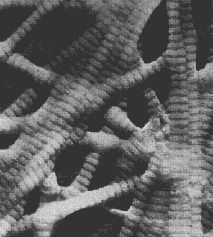Collagens
Collagens are
- insoluble, extracellular glycoproteins
- found in all animals
- the most abundant proteins in the human body
They are essential structural components of all connective tissues, such as
- cartilage
- bone
- tendons
- ligaments
- fascia
- skin
19 types of collagens have been found (so far) in humans. The major ones are:
- Type I. The chief component of tendons, ligaments, and bones.
- Type II. Represents more than 50% of the protein in cartilage. It is also used to build the notochord of vertebrate embryos.
- Type III. Strengthens the walls of hollow structures like arteries, the intestine, and the uterus.
- Type IV. Forms the basal lamina of epithelia. (The basal lamina is often called the basement membrane, but is not related to lipid bilayer membranes.) A meshwork of Type IV collagens provides the filter for the blood capillaries and the glomeruli of the kidneys.
The other 15 types are probably equally important but they are much less abundant.
Primary structure of collagens
The basic unit of collagens is a polypeptide consisting of the repeating sequence
(glycine (Gly) - X - Y)n
where X is often proline (Pro) and Y is often hydroxyproline (proline to which an -OH group is added after synthesis of the polypeptide).
Secondary and tertiary structure
The resulting molecule twists into an elongated, left-handed helix (NOT an alpha helix).
When synthesized, the N-terminal and C- terminal of the polypeptide have globular domains, which keep the molecule soluble.
As they pass through the endoplasmic reticulum (ER) and Golgi apparatus,
- The molecules are glycosylated.
- Hydroxyl (-OH) groups are added to the "Y" amino acid
- S-S bonds link three chains covalently.
- The three molecules twist together to form a triple helix.
In some collagens (e.g., Type II), the three molecules are identical (the product of a single gene). In other collagens (e.g., Type I), two polypeptides of one kind (gene product) assemble with a second, quite similar, polypeptide, that is the product of a second gene.
 When the triple helix is secreted from the cell (usually by a fibroblast), the globular ends are cleaved off. The resulting linear, insoluble molecules assemble into collagen fibers. They assemble in a staggered pattern that gives rise to the striations seen in this electron micrograph (courtesy of Dr. Jerome Gross). (Type IV collagens are an exception; they form a meshwork rather than striated fibers.)
When the triple helix is secreted from the cell (usually by a fibroblast), the globular ends are cleaved off. The resulting linear, insoluble molecules assemble into collagen fibers. They assemble in a staggered pattern that gives rise to the striations seen in this electron micrograph (courtesy of Dr. Jerome Gross). (Type IV collagens are an exception; they form a meshwork rather than striated fibers.)
Inherited diseases caused by mutant collagen genes
Brittle-bone disease ("osteogenesis imperfecta")
Caused by a mutation in one or the other of the two genes whose products are used to make Type I collagen. Like all the inherited collagen diseases, this one is inherited as a dominant trait. The reason: even though one collagen allele is normal, the assembly of the normal gene product with the mutant product produces defective collagen fibers.
Some forms of dwarfism
Caused by a mutation in the Type II collagen gene.
Rubber-man syndrome
Caused by a mutations in a Type I collagen gene. The subject has hyperextensible joints, tendons, and skin.
(This inherited disorder represents one type of Ehlers-Danlos syndrome.)
Another Type of Ehlers-Danlos Syndrome
Is caused by mutations in the gene for Type III collagen. Patients are at risk of rupture of major arteries or the intestine.
Herniated discs between the vertebrae?
A study in Finland has found that some families that share a tendency to develop herniated discs (leading to sciatica) have an inherited point mutation in the gene (COL9A2) encoding one of the alpha chains in collagen IX. This collagen is one component of the extracellular matrix in the padding (discs) between our vertebrae.
Caused by a deficiency of vitamin C. The sufferer is unable to add hydroxyl (-OH) groups to proline to convert it into hydroxyproline.
24 July 1999
 When the triple helix is secreted from the cell (usually by a fibroblast), the globular ends are cleaved off. The resulting linear, insoluble molecules assemble into collagen fibers. They assemble in a staggered pattern that gives rise to the striations seen in this electron micrograph (courtesy of Dr. Jerome Gross). (Type IV collagens are an exception; they form a meshwork rather than striated fibers.)
When the triple helix is secreted from the cell (usually by a fibroblast), the globular ends are cleaved off. The resulting linear, insoluble molecules assemble into collagen fibers. They assemble in a staggered pattern that gives rise to the striations seen in this electron micrograph (courtesy of Dr. Jerome Gross). (Type IV collagens are an exception; they form a meshwork rather than striated fibers.)